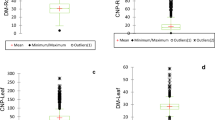Abstract
The chemical composition, including the proximal composition, cyanide and amino acid concentrations of leaves and root tissues, as well as the starch and sugar concentrations of root peel and parenchyma, of low-(M Col 113), intermediate-(M Col 22 and the hybrid CM 342-170) and high-(M Col 1684) cyanide-containing cassava cultivars at four plant ages (6, 8, 10 and 12 months) is presented. The local cultivar (M Col 113) showed lower leaf and root parenchyma dry matter contents, lower crude fiber and crude protein levels in root peel, a higher sugar content and lower cyanide concentration in root tissues, than the other three cultivars (M Col 22, CM 342-170 and M Col 1684). Most of the parameters studied were affected by the cultivar as well as by plant age. Less variability was observed for all criteria in the root parenchyma than in the leaves and root peel. The sulfur-containing amino acids were low in all tissues analyzed and a high concentration of arginine was found in the root tissue samples. The cyanide concentration of root parenchyma was less variable than that of leaves and root peel; the cultivar M Col 1684 showed a higher cyanide concentration in the parenchyma (900 to 1000 mg/kg DM) than the other three cultivars, which ranged from 100 to 200 mg/kg DM. The local cultivar (M Col 113) was the only one in which the cyanide concentration in leaves was higher than that of the root peel. The hybrid CM 342-170 produced roots with the highest dry matter and starch concentrations.
Similar content being viewed by others
References
AOAC (1970) Official Methods of Analysis. Association of Official Analytical Chemists, Washington D.C., 11th edn
Barrios EA, Bressani R (1976) Composición quimica de la raiz y de la hoja de algunas variedades de yucaManihot. Turrialba 17:314–320
Blackburn S (1978) Sample preparation and hydrolytic methods. In: Blackburn S (ed) Amino acid determination, 2nd edn, Marcel Dekker, Inc. New York, pp 9–10
Blake CJ, Coveney LV (1978) The determination of starch in foods. 1. An evaluation of acid and enzymatic hydrolytic methods for native and modified powdered starches. Research Report No 293. The British Food Manufacturing Industries Research Association, p 16
Cock JH (1982) Cassava: A basic energy source in the tropics. Science 218:755–762
Cooke RD (1978) An enzymatic assay for the total cyanide content of cassava (Manihot esculenta Crantz). J Sci Food Agric 29:342–352.
Cooke RD, De La Cruz Elba M (1982) The changes in cyanide content of cassava (Manihot esculenta Crantz) tissues during plant development. J Sci Food Agric 33:269–275
Cronin DA, Smith S (1979) A simple and rapid procedure for the analysis of reducing, total and individual sugars in potatoes. Potato Res 22:99–105
Eggum BO (1970) The protein quality of cassava leaves. Br J Nutr 24:761–768
Gómez G, De La Cuesta Déborah, Valdivieso M, Kawano K (1980) Contenido de cianuro total y libre en parénquima y cáscara de raíces de diez variedades promisorias de yuca. Turrialba 30:361–365
Gómez G, Valdivieso M (1983) The effect of variety and plant age on cyanide content, chemical composition and quality of cassava roots. Nutrition Reports International 27:857–866
Gómez G, Valdivieso M (1983) Changes in cyanide content of cassava tissues as affected by plant age and variety. 6th Symposium Intern. Soc. for Tropical Root Crops, Lima, Peru, 21–26 February 1983 (In press)
Hahn SK, Terry ER, Leuschner K, Singh TP (1981) Tropical Root Crops: Research Strategies for the 1980's. Intern. Dev. Res. Centre, Ottawa, Canada, IDRC-163e, pp 25–28
Hunt LA, Wholey DW, Cock JH (1977) Growth physiology of cassava (Manihot esculenta Crantz). Field Crop Abst 30:77–91
Kawano K, Daza P, Amaya A, Ríos M, Goncalves Wania MF (1978) Evaluation of cassava germplasm for productivity. Crop Science 17:377–380
Ketiku AO, Oyenuga VA (1970) Preliminary report on the carbohydrate constituents of cassava root and yam tuber. Nigerian J Sci 4:25–29
Mota Teresa P (1970) Características químico-analíticas de algunas mandiocas en ensaio. Agron moçamb., Lourenço Marques 4:21–29
Nartey F (1978)Manihot esculenta (cassava). Cyanogenesis, ultrastructure and seed germination. Munksgaard, Copenhagen, Denmark, p 262
Obigbesan GO, Fafunso M (1980) Some chemical components of Nigerian cassava cultivars and of the processed product. Der Tropenlandwirt, Zeitschrift für die Landwirtschaft in den Tropen and Subtropen 81:151–161
Oyenuga VA (1955) The composition and nutritive value of certain feeding-stuffs in Nigeria. I. Roots, tubers and green leaves. Empire J Exper Agric 23:81–95
Ramos-Ledon LJ, Popenoe J (1970) Comparative chemical composition of cultivars ofManihot esculenta Crantz and some related species. Proc Tropical Region, Amer Soc Horticultural Sci 14:232–234
Statistical Analysis System (1979) User's Guide 1979 edn. SAS Institute Inc, Raleigh NC, p 494
Ternes M, Vizzotto VL, Mondardo E (1981) Variação do teôr de amido no cultura do mandioca em Santa Catarina. Anais do 2° Congresso Brasileiro de Mandioca, Vitoria-Espírito Santo, 29 noviembre-4 diciembre 1981, pp 128–141
Wholey DW, Booth RH (1979) Influence of variety and planting density on starch accumulation in cassava roots. J Sci Food Agric 30:165–170
Author information
Authors and Affiliations
Rights and permissions
About this article
Cite this article
Gómez, G., Valdivieso, M. & Noma, A.T. The influence of cultivar and plant age on the chemical composition of field-grown cassava leaves and roots. Plant Food Hum Nutr 35, 109–119 (1985). https://doi.org/10.1007/BF01092126
Received:
Revised:
Issue Date:
DOI: https://doi.org/10.1007/BF01092126




